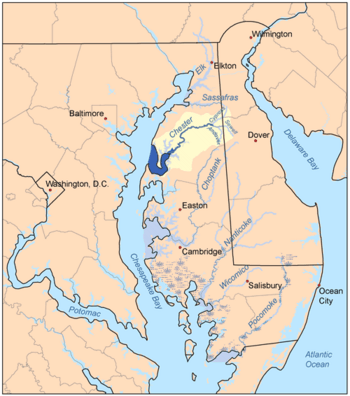Chester River facts for kids
Quick facts for kids Chester River |
|
|---|---|

Map of the rivers of the Eastern Shore of Maryland with the Chester and its watershed highlighted.
|
|
| Country | United States |
| State | Maryland |
| District | Kent County, Maryland Queen Anne's County, Maryland |
| Physical characteristics | |
| Main source | Andover Branch / Cypress Branch Millington, Maryland 0 ft (0 m) |
| River mouth | Chesapeake Bay Love Point 0 ft (0 m) |
| Basin features | |
| Tributaries |
|
The Chester River is an important river that flows into the Chesapeake Bay. It's located on the Delmarva Peninsula, a piece of land shared by Delaware, Maryland, and Virginia. This river is about 43 miles (69 km) long.
The area of land and water that drains into the Chester River is called its watershed. This watershed covers about 368 sq mi (950 km2). Most of this area, 295 sq mi (760 km2), is land.
The Chester River forms the boundary between Kent County and Queen Anne's County in Maryland. Its very beginning, called the headwaters, reaches into New Castle County and Kent County in Delaware. The town of Chestertown, which is the main town in Kent County, sits on the river's north side.
Where the River Starts and Ends
The Chester River officially begins in Millington, Maryland. This is where two smaller streams, Cypress Branch and Andover Branch, meet.
- Cypress Branch starts in southwestern New Castle County, Delaware.
- Andover Branch, along with its own small stream called Sewell Branch, starts in northwestern Kent County, Delaware.
These branches join together to form the Chester River. The river then flows all the way to the Chesapeake Bay. It ends in a wide mouth between Love Point on Kent Island and Swan Point, near Gratitude, Maryland.
Smaller Streams and Creeks
Many smaller streams and creeks flow into the Chester River. These are called tributaries.
- On the north side, important tributaries include Langford Creek and Morgan Creek. Other smaller ones are Church Creek, Grays Inn Creek, and Broad Creek.
- On the south side, the Corsica River and Southeast Creek are major tributaries. Other smaller ones include Queenstown Creek, Tilghman Creek, and Rosin Creek.
A Bit of History
The Chester River has a cool story from the past. In 1774, colonists in Chestertown (which was also called New Town on Chester back then) were upset about taxes on tea. They heard that a British ship carrying tea was anchored in the river.
People in Chestertown held meetings to talk about the tea. Some stories say that colonists boarded the ship and threw the tea overboard. This event became known as the Chestertown Tea Party. It was similar to the more famous Boston Tea Party, where colonists also protested against taxes.
While we know Chestertown residents were upset about the tea and later helped people in Boston, historians are still looking for more old documents to fully confirm all the details of the "tea party" event in Chestertown.

